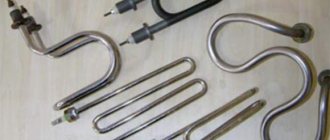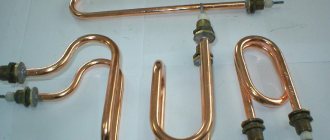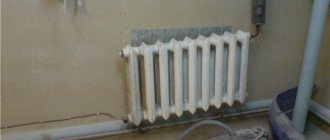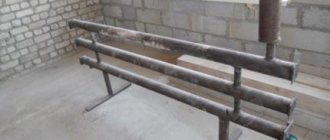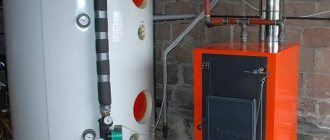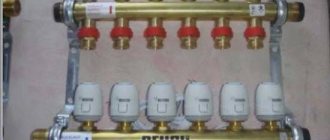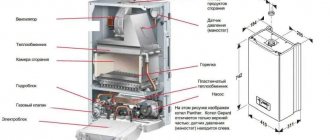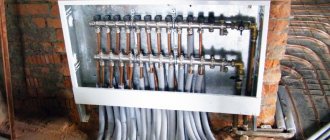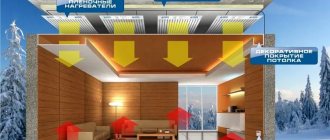Electric heating elements have not changed their design for decades and remain in demand in heating equipment. The shape of these devices and construction materials change, but the principle of operation and efficiency remain unchanged. For a competent selection, information about the differences and characteristics will be useful. Do you agree?
You will learn what heating elements for heating are and how they work. We have described in detail the types of heating elements and provided indisputable arguments for an informed choice of the optimal type. Taking into account our recommendations, you will purchase the required device without errors.
Purpose of heating heating elements
Electric heating elements have gained popularity due to their versatility and high efficiency. All the electricity they consume is used for its intended purpose - heating the surrounding space.
The main heating devices where heating elements are used are:
- Portable and stationary oil electric heaters.
- Water heating radiators.
- Bathroom heated towel rails.
- Electric fireplaces.
- Electric convectors.
- Electric boilers.
The specified equipment can be used as a main or additional heating source. It is inexpensive, easy to install and does not require special skills to operate.
You can connect the heating element to a cast iron central heating radiator after disconnecting the common riser. This device can be used for main and additional heating
Application
In what cases does it become advisable to operate a heating system based on electric heating elements? These elements can be used to organize autonomous, local heaters, additional heating of the coolant, or in the structure of a centralized heating system.
This solution seems especially relevant if it is necessary to create an “emergency” heating system for housing. In case of extremely unstable heating operation, the heaters maintain a comfortable level of heat and protect the radiators from freezing.
The use of functional thermostats along with heaters allows you to accurately adjust the temperature of the coolant. The presence of special temperature sensors protects the device from overheating.
In addition to the main ways to use shadows, there are a number of additional functions:
- “Turbo” mode - with appropriate control of the thermostat, the heating element produces maximum power for some time. This makes it possible to quickly and efficiently heat the room until the required temperature is reached.
- Anti-freeze function - maintains a minimum temperature, preventing the coolant from freezing in the heating radiator.
Internal structure of electric heaters
It is convenient to consider the device using the example of a tubular model. An electric heater is a ceramic or metal tube filled with a thermal conductor with a spiral located inside. In the place where the tube is fixed to the flange there are insulating bushings that make it impossible for the conductive spiral to contact the heating element body.
Most models of heating elements use similar components, but their durability may vary depending on the build quality
The electric heater is mounted primarily with a flange connection, which allows the internal environment of the heating device to be sealed from the external space. The disadvantage of this design is the impossibility of replacing the spiral if it burns out internally.
Safety precautions and operational points
A heating element is a mains-powered heater. When using the device, it is quite important to follow some rules that will ensure safe use and significantly extend its service life:
- In order for the device to operate for a long time with full heat transfer, the scale that forms on its surface should be cleaned once every three months. If a large layer of white deposits forms, it can damage the device. The intensity of scale formation can be reduced by using distilled water as a coolant.
- Do not allow the electric heater to overheat. The temperature of the radiator in the place where the electric heater is installed should not reach seventy degrees above zero. Therefore, it is quite important to choose the correct power of the heating element.
- The heater can only be turned on in a battery filled with coolant. If water enters an already heated electrical appliance, it can lead to a thermal explosion. As a result, not only the radiator, but the entire heating system may be damaged.
- If static electricity appears on the surface of a tubular device, it must be immediately turned off and all connections and the device itself checked for leaks.
- The heater power should not be higher than the thermal rated power of the battery. A load of no more than 3.5 kilowatts is allowed in one outlet.
The temperature of the heating element for the radiator must not reach 70 degrees.
Installation of the heating element in the heating radiator is carried out only using grounding. To avoid voltage drops, it is best to connect the electric heater to the network through a stabilizing device.
Operating principle of heating elements
The heating element works according to the following principle. When connected to the network, the internal spiral is heated and energy is transferred to the thermal conductor and the outer shell. The heat is then transferred to the surrounding fluid, air or solid material.
When heating a heating element immersed in oil or water, convection currents are created around the tube, which mix the coolant and contribute to its uniform heating.
Electric boilers are known for their reliability and maintainability. They do not have many complex parts, so they are easy to operate and maintain.
In liquid-free heating devices, the heating temperature is usually limited so as not to damage surrounding parts or cause a fire.
To speed up heat transfer, they often use a fan, which circulates air both inside the device and in the room surrounding it.
Electrode electric boiler
Electrode electric heating boilers are characterized by high productivity and efficiency. Heating of the coolant occurs almost instantly. Hot water begins to flow into the heating system just a few minutes after the electric boiler is turned on.
The efficiency of electrode-type electric boilers is almost 50% greater than that of heating element analogues. There are also disadvantages associated with the internal structure and operating principle.
Design and principle of operation of an electrode boiler
The operating principle of an electrode electric boiler is associated with the direct effect of electric current on the coolant. Heating electrodes are positively and negatively charged. An electromagnetic field is created, under the influence of which the ions begin to move chaotically, with an intensity of at least 50 vibrations per second.
In the process of heating the coolant, electrolysis gas is formed, therefore, from time to time, you will have to bleed the air from the heating system.
The advantage of an electrode boiler is the high efficiency of heating the coolant, due to the absence of intermediaries in heat transfer. There are also limitations. The coolants on which electrode electric boilers operate have a high salt content. You can make your own saline solution, but, as practice shows, it is better to use ready-made mixtures.
The material that makes up the electrode in the boiler must be neutral to scale formation, have good throughput and a long service life. Manufacturers use three types of materials. Budget electric boilers are equipped with graphite and stainless steel electrodes. Premium boilers are equipped with titanium rods.
Types of heating elements for heating devices
The simplicity of manufacturing heating elements does not always translate into convenience for users. Many manufacturers produce electric heaters with a specific shape and mounting. If they break, they are quite difficult to buy in a store. Therefore, to make the right choice, it is necessary to study all possible design options.
Tubular models for domestic heating
The tubular design of electric heaters is the most common in mobile oil heaters, portable and wall-mounted electric radiators. Heat transfer in them can occur using: convection, infrared radiation or thermal conductivity.
Ready-made heating elements with a regulator and their own power cord can only be purchased if you are sure that the wire length will be sufficient
The shape and length of the tube in such devices can be any and is dictated only by design features. For example, the heating element of a micatremic heater is a coil located behind a mineral plate. When heated, the plate emits infrared heat.
Its most common characteristics are:
- diameter – 5-18 mm;
- length – 200-6000 mm;
- shell material – steel, stainless steel, ceramics, copper;
- power – 0.3-2.5 kW.
Heating elements with a power of more than 2.5 kW are not used in household heating devices, because apartment wiring simply cannot withstand the greater load.
Finned version of electric heaters
Finned devices are a modification of a tubular heating element. Their feature is the presence of many thin steel plates located along the entire length of the device. This design dramatically increases the area of contact with the environment, ensuring a high heating rate.
Finned heating elements are more expensive and require more work space, but provide higher consumer characteristics of heating equipment
Finned models are used mainly in heaters for air heating. They provide a quick increase in room temperature, especially with a built-in fan.
Block designs of heating elements
The block version consists of several tubular heaters combined on the basis of a single mounting.
When choosing block heating elements, special attention must be paid to their power and the ability of the boiler with a pump to provide heat removal
This design is used by a combination of two factors:
- The need for increased device power and high heating rate of the working environment.
- The impossibility of rapid transfer of thermal energy from the spiral to the environment due to the small area of the outer shell.
In fact, in a block heating element, the load on each heating tube is reduced and the heat transfer rate is increased. Such devices are part of household heating boilers and industrial electric heating installations.
The power of block models can be 5-10 kW, so when placing them in an apartment, it is necessary to extend an additional electrical cable into the room.
Cartridge-type devices
Cartridge heating elements have the form of a tube with one free end, which is due to the peculiarity of their installation. The outer shell is usually made of polished steel to provide maximum contact with the surrounding material. Such tubes are tightly inserted into the corresponding hole in the heating device.
The main disadvantage of cartridge heating elements is the small area of the heat-transferring surface, which requires the use of specific methods for removing thermal energy
Fixation of cartridge models is carried out mainly using a flange connection. They are usually used in industry to heat the working parts of extruders.
There are other structural types of heating elements, but they are used mainly in industrial production and do not affect the topic under consideration.
Using TENs
Recently, more and more people are thinking about the possibility of autonomous heating of their home. Every year the cost of traditional heating increases, so quite often with the help of an autonomous system there is a chance to save money.
Also, sometimes there is simply no possibility of connecting to a central heating system - this is especially true for holiday villages. The only option to heat the house in this case is to install a heating boiler. Solid fuel and gas boilers continue to be the most popular, but their use is also not always possible - access to the main gas pipeline is not always available.
The best way out of such situations is to install electric heating equipment, since electrical networks are available almost everywhere. The main element of any such heating device is TEN. The efficiency of the heating system largely depends on its type. Typically, household heating equipment uses tubular heating elements, as well as elements with a thermostat. The latter make it possible to regulate the operation of the heating system.
Electric heating systems are very convenient to use: they do not emit harmful substances, since they do not form combustion products, do not require installation in a separate room, are safe to use, and are easy to install and adjust. But still, when installing electric heating equipment, you should first check whether the electrical network can withstand the high load. You also need to prepare in advance for the fact that you will have to pay a lot of money for electricity.
Additional functions of electric heaters
Above we discussed the simplest designs of devices that do not have any built-in adjustment mechanisms.
The thermoregulation unit can have mechanical or electronic automation. The latter is more accurate, but is demanding on the parameters of the home electrical network
But electric water heaters can be equipped with simple automation that provides the device with additional functions.
These include:
- Thermoregulation . Heating elements with a built-in thermostat for heating have a temperature sensor that is triggered when the working environment is heated to a certain level. The electric heater is adjusted from the outside of the flange.
- Antifreeze . This function is provided by a simplified thermostat, which operates only when the temperature drops to 0-2°C. It prevents water from freezing in heating pipes, consuming a minimum of electricity.
- Turbo heating , which provides forced heating of the working environment during the initial start-up of equipment. It must be remembered that the electrical wiring of the room must withstand a short-term increase in power.
There are not many devices that support additional functions, because the operation of heating devices as a whole is often regulated using a separate automation unit.
Installation stages
Regardless of the manufacturer, heating elements are installed in heating radiators according to a single principle. To install the heating element yourself, just follow the instructions:
- The device where installation will be carried out must be de-energized.
- The supply of working fluid to the batteries is stopped, after which it is drained.
- Instead of the bottom plug, a heating element is installed, which must go into the water supply pipe.
- The fluid supply is restored, and then the radiator is checked for leaks.
- The heating element is connected to the electrical network.
Precautionary measures
When using heating elements for radiators of a heating system, you must adhere to certain safety requirements. When installing heating, it is important to check the reliability of the ventilation. Also, when performing work, it is necessary to move flammable and explosive substances to a protected, hard-to-reach place at a safe distance from the heating device. Before connecting a heating device with a heating element and a thermostat, it is worth checking once again how well the electrical wiring can cope with the load placed on it
Exceeding the permissible power is fraught with overheating of the wires, short circuits and fires.
- When connecting heating devices with heating elements, you should avoid using ordinary household carriers. The best option is to use network filters. This solution allows you to automatically de-energize the device during voltage surges in the system.
- It is absolutely unacceptable to use batteries with an electric heating element to dry things.
- When the heating element operates, the working fluid is intensively heated. Its operation for a long time leads to the burning of oxygen. Therefore, staying in such a room for a long time poses a health hazard.
How to choose a heating element for heating equipment?
When choosing a heating element to replace in a water heater or radiator, you need to pay attention to its power, design, tube length and the availability of additional capabilities. Therefore, before purchasing, you need to find out as much as possible about all its characteristics.
Calculation of device power
The high power of a heating element is not always a positive quality.
When choosing, it is important to consider several factors that are related to the level of energy consumption:
- maximum heat transfer power of the heating device as a whole;
- electrical wiring options;
- room volume.
You cannot buy a device with a power that is more than 75% of the maximum heat transfer level of heating equipment.
For example, there is a radiator with 10 sections, each of which releases 150 W of heat to the air, a total of 1.5 kW. When installing an electric heater with a power of 2 kW into it, the surface of the battery will not be able to quickly release all the energy generated. As a result, the heating element will constantly turn off due to overheating.
The reason for the rapid breakdown of the heating element may be the incorrect choice of device power. As a result of systemic overheating of the coil, it burns out over time.
In apartments with worn-out wiring, the constant load on the outlet should not exceed 1.5-2 kW, otherwise it may catch fire and lead to dire consequences. Therefore, before purchasing a heating element, you need to check the condition of the wiring and, if necessary, dismantle the old one and install a new electrical network.
When the issue with electrical equipment and equipment capabilities has been resolved, you can begin to calculate the required power to maintain a comfortable temperature in the room.
In well-insulated houses and apartments, a level of 40 W/m3 will be sufficient. And if there are cracks in the windows, the heating power should be increased to 60-80 W/m3. You can buy a specific model only after taking into account all the energy factors described above.
Consideration of design features
Most heating elements have an alloy steel shell, which provides strength and resistance to corrosion. Copper devices are used primarily in water heaters, although there are no restrictions on their use in homemade radiators.
In cast iron and steel radiators, the use of heating elements made of non-ferrous metals is undesirable. This can lead to accelerated wear of materials and connections.
Also, when choosing, it is necessary to take into account the direction of the thread of the plug, which can be right or left. Different models of electric heaters also differ in flange diameter. They can range in size from 0.5 to 1.25 inches.
Typically, a heating element from a good manufacturer comes with a brief instruction manual that describes its design parameters. Studying them will help you buy a device that will exactly fit your existing heating equipment.
Heating tube length
The length of the tube is one of the main characteristics that determine the efficiency of the device.
Its large length with equal power leads to an increase in the surface area of the electric heater and acceleration of heat exchange with the working environment. This has a positive effect on the durability of the heating element and the coolant circulation rate.
Heating elements with a long tube are ideal for installation in homemade registers, which are convenient for heating large rooms and outbuildings
It is desirable that the tube runs along the entire length of the working area of the heating device, without reaching the opposite wall by 6-10 cm. This recommendation will allow you to quickly and evenly warm up the coolant.
Availability of additional functionality
It is not always necessary to overpay for the additional capabilities of heating elements. If the heating device is used as an auxiliary device and does not have its own built-in automation, then purchasing a model with a thermostat makes sense.
But if a radiator or electric convector has its own temperature sensors and temperature control mechanisms, additional functions will remain unclaimed.
The electronics built into the heating element plug must have safety mechanisms so that if the control board breaks down, a fire does not occur.
Therefore, it is recommended to purchase expensive electric heaters with built-in automation only if there is a clear need for such equipment. If you need to individually select the temperature background, it is better to buy a thermostat for an outlet that can be used periodically.
As for the manufacturers of heating elements, their choice is not important. The main suppliers are companies from Russia, Ukraine, Turkey and Italy. The quality of their products is approximately the same, so there is no point in overpaying for the brand.
Choice
When determining the required power, it is worth proceeding from considerations of heat transfer from the radiator and incomplete use of the power of the tubular electric heater. For example, battery sections made of cast iron “give” 140 W, and those made of aluminum – 180 W.
Thus, in the first case, a radiator of ten ordinary sections will require a heating element power within 1 kW, in the second case, a heating element for an aluminum radiator should have a power of 1.4 kW.
- The length of the tubular electric heater directly affects the quality of circulation inside the radiator
; therefore, in the optimal case, the length of the heating element should be only a few centimeters shorter than the battery. - Structurally, heating elements differ in the material from which the plug is made and the shape of the outer part of the housing
. The standard plug has a diameter of 1 1/4″, and the thread type can be either right-handed or left-handed.
- The automation system that controls the tubular electric heater can be built inside the tube or located outside; the instructions for installing it in this version are simple. In the latter case, the heating element is connected through a thermostat, which controls the temperature in the room. In the case of internal installation, the sensor measures the temperature of the coolant, and the thermostat is installed in the outer part of the housing.
